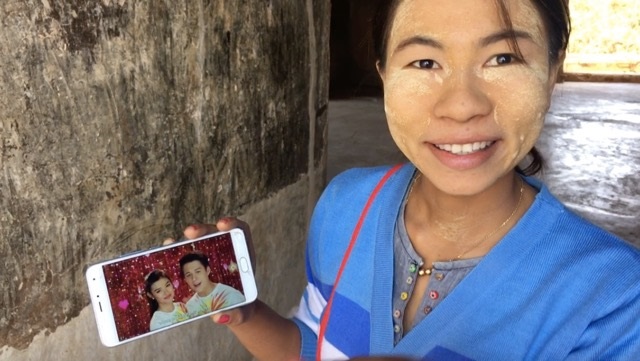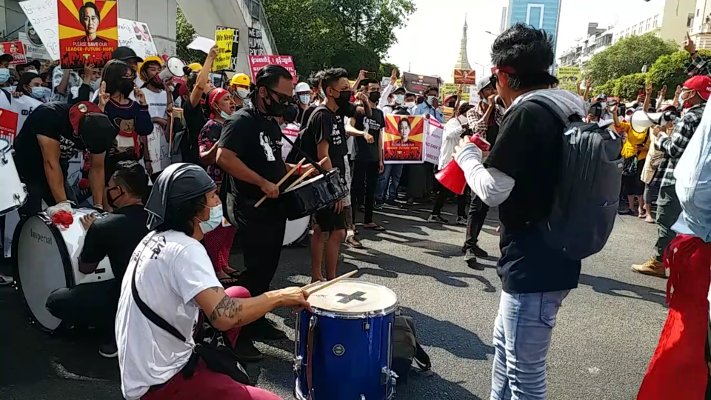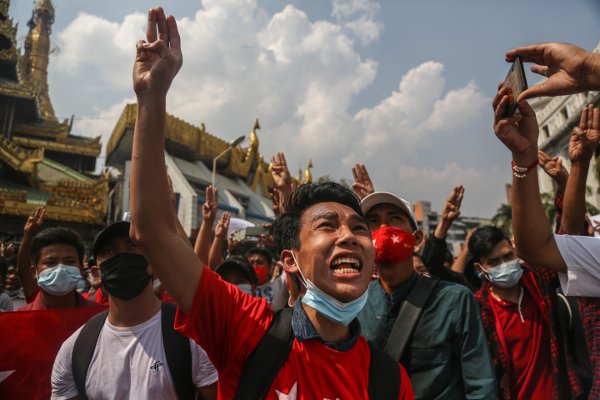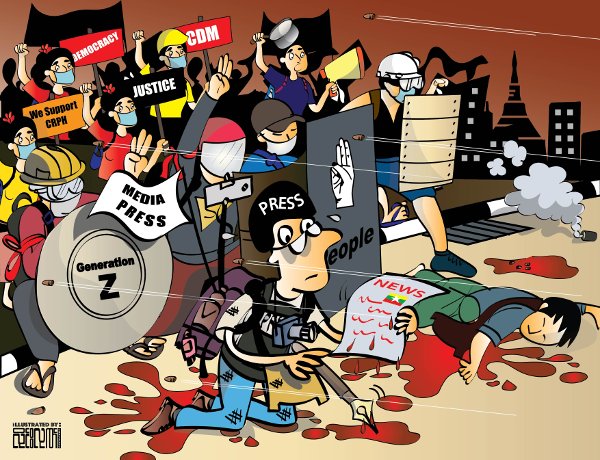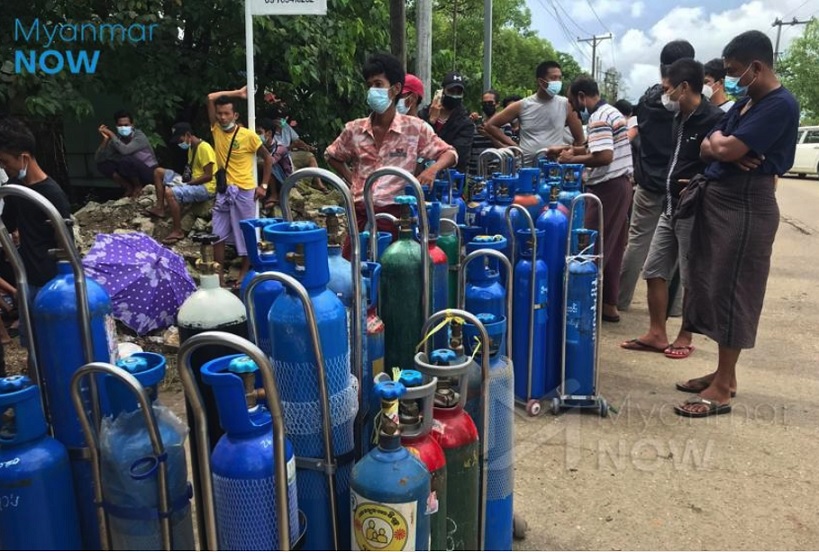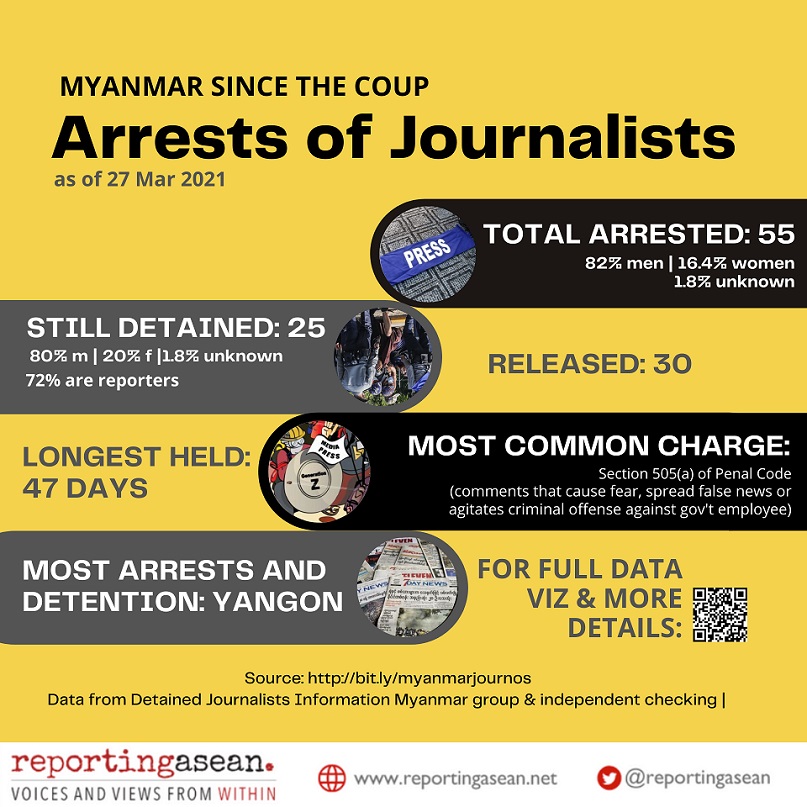
YANGON AND BANGKOK- “In media training, we say that journalism is not a crime,” recalls Tin Zar Zaw, a journalist with two decades’ experience in training. Indeed so, but what do you do when your profession is effectively classified as a crime?
Like protesters, activists and citizens, journalists have been at the receiving end of the military’s rampage of violence since late February, weeks into the Feb 1 coup by Myanmar’s armed forces.
Two months after the takeover, being a journalist has, by itself, become a risk in a country has a long tradition of reading, be it news or journals or poetry.
Many are being hunted down, or arrested or targeted while on coverage. As of 30 March, a total of 57 journalists, from reporters to publishers to photojournalists, have been arrested and a number injured. Twenty-seven are in detention.
These days, journalists are working while on the run, even with little or no pay, and using whatever internet they can find. Many too have lost their jobs and have not received employment benefits from companies, much less protection.
Some journalists have had to call it quits or lie low for a while. Their options are limited not just by the brutality around them, but by realities such as running out of cash, inability to get proper medical treatment and the need for for safer places to stay in. Others have had to flee to safety.
“We have to change places to sleep at night times because of security concerns. When dogs bark at night, we dare not sleep (deeply). Even in daytime, we feel insecure to do our duty,”said one journalist in central Mandalay region.
Myanmar’s media houses – those that are still reporting – soldier on despite the nightly internet shutdowns, cutoff of mobile data services and the military’s attempts to block access to their sites. These include four of the five independent outlets whose licenses were revoked by the military’s State Administrative Council in early March. 7 Day News closed all its digital platforms, but others – Democratic Voice of Burma, Myanmar Now, Mizzima, Khit Thit media – continue online.
Many other outlets, including smaller ones, closed in the mayhem after the coup, so that all hard-copy newspapers and journals had stopped printing by Mar 17.
There are some 4,000 journalists in news organizations in Myanmar, going by estimates of the Myanmar Press Council, which collapsed in February.
While a crackdown is far from unexpected, Myanmar’s crisis comes down heavily on a news industry that is a fledgling one a decade into the country’s now-halted democratisation process. Journalists and Myanmar’s news community now find themselves in a no-safety zone.
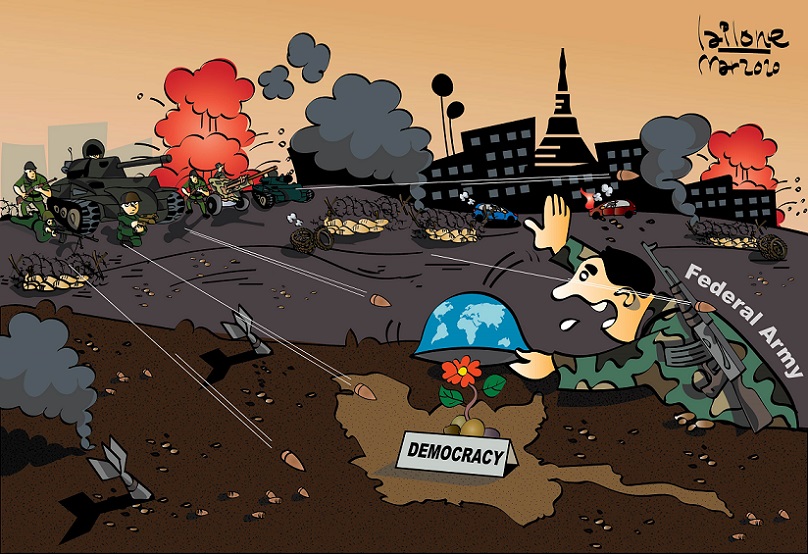
Editorial cartoon by Reporting ASEAN
The five points below describe the realities that Myanmar journalists face:
1.Far from the ideal before the coup, the work environment for the media has deteriorated sharply since late February, while the risks have escalated. There has been no respect for the media’s work.
Safety guidelines for journalists prescribe putting on badges, vests, and other gear that identify them as media. While such badges were given soon after the Feb 1 coup, wearing them gave little protection, or became a risk as well. Journalists have been arrested while reporting, others picked up at home, without warrants and civilian witnesses.
“We could cover protest news, staying close to the security police, earlier,” the Mandalay-based recounted. “In later days, police used slingshots against journalists wearing ‘PRESS’ jackets and helmets. Then we noticed that the security forces were targetting the journalists intentionally. Yesterday, police chased journalists using motorbikes and we have to run away for safety.”
Journalists have to watch out for informers and be careful of being mistaken as informers themselves. They are wary of what they “psy-war” tactics by military agents who spread false news and disinformation through social media.
“The reporters are sandwiched between security police and suspicious protesters who are stressed (out) by social media. When a reporter uses a camera during a protest, protesters (can) consider him as an informer or Trojan (horse), while police target him as their enemy,” said another reporter. “There are no words to say how dangerous covering a news story is.”
2. Most of the charges brought by the military against the arrested journalists have to do with security issues.
As of Mar 30, just over half of the still-detained 27 journalists have been charged with Section 505 (a) of the Penal Code, which criminalizes comments that “cause fear”, “spread false news [or] agitates directly or indirectly a criminal offense against a Government employee”. This refers to content deemed to have dishonored Myanmar’s armed forces, and conviction carries a jail term of up to three years.
It is not always known where the journalists are held. Groups tracking arrests may not know of some incidents until later. Lawyers have volunteered to represent the journalists.
There are even fewer journalists using bylines these days. But many freelancers and unemployed news staff continue to send content to the other media outlets, as do citizen journalists.
3.The norms for work practices, including salaries, in Myanmar’s media industry are different from those overseas. The assumptions that apply to journalists elsewhere may not hold in the country’s setting.
The legal, business and employment infrastructure in Myanmar around journalism is a work in progress. The industry has some ways to go in terms of salaries and benefits, and employment arrangements.
Salaries differ across newsrooms, but it is not unusual for a reporter to have monthly pay equivalent to 105 dollars, though this can reach 350 dollars in a bigger media house. In some cases, journalists get a basic salary of 140 dollars a month and get paid more depending on how many articles they file. An editor at a local newspaper could earn 500 dollars per month.
Salaries outside the capital or major cities tend to be lower. One chief editor in Magway says he gets 150 dollars a month, an editor 120 dollars and a reporter, 90 dollars.
Likewise, it cannot be assumed that all journalists have their own news equipment. Since many journalists were using workplace computers, and newsrooms are now shut, they no longer have the tools of their trade. Not all news offices cover equipment or communication costs, or other costs like insurance.
4.The crackdown on media harms not only press freedom and the public’s right to know. It undercuts the livelihoods of journalists and the larger news profession, which were already reeling under the economic crisis brought by COVID-19.
“I’ve been relying on media industry to feed four family members. Media houses have been shut down and we couldn’t get compensation. We face big difficulties in daily life as we have no extra savings,” another journalist in Mandalay said.
In truth, many lost their jobs after COVID-19 kicked in last year and by the time the coup happened, they were no longer being paid in full. Some media owners arranged compensation but many did not, or could not. Freelancers are on their own.
“Since the military coup happened, job opportunities for journalists decrease day by day,” said a freelancer based in Yangon.
The current crisis has exposed the vulnerabilities of a still-young news sector, one whose space in society did not have enough support through legislation and professionalization of business practices before the coup. The National League of Democracy-led government had come under fire for failing to take out media-repressive laws, which the military found useful.
5. Journalists and media houses are determined to continue reportage, with the help of online platforms. But big questions loom about the future, and how professional news work can be supported over the longer term.
While journalists are preoccupied with survival, they wonder what lies ahead. “After this unusual crisis, journalists shouldn’t (end up) migrating to other callings,” said the trainer, Tin Zar Zaw. “If we cannot help the sustainability of media platforms, most journalists would have to move to other occupations. That would bring (us to) despair.”
For now, many news ‘outlets’ have sprung up on social media. So have new solidarity groups among journalists.
What happens to all the investment that foreign donors put into media development and training in the recent past? This has helped several media houses and training institutes keep going, but what happens next depends how foreign governments respond to Myanmar’s coup.
“At this moment, the future of Myanmar media and journalists seems extremely uncertain,” Tin Zar Zaw pointed out. That may well be an understatement at a time when the ranks of Myanmar’s hardy profession are thinning out, whether through arrests or joblessness.
Still, the current mood, given the broad-based opposition to the military coup, is one of sharing of news without thinking of getting credit or payments because of the knowledge, from past experience, that all of them lose if the Myanmar military holds power. “Most Myanmar journalists are happy covering daily news even though they don’t get any earnings,” said the Yangon reporter.
(This feature is part of the ‘Lens Southeast Asia’ series of the Reporting ASEAN programme.)
